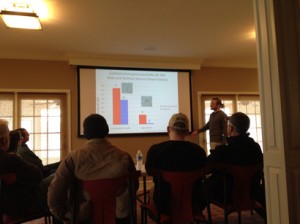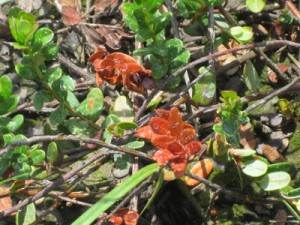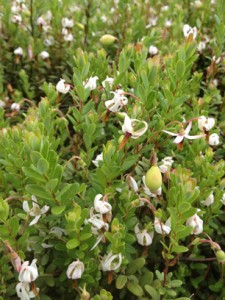On Wednesday, our Integrated Crop Management (ICM) team had a chance to sit down with Dr. Peter Oudemans and graduate student Tim Waller of Rutgers University to hear about Tim’s research on the window for fruit rot control. Tim, who earned his undergrad degree in Biological Sciences from Rutgers, got his first research experience with blueberries, studying black shadow disease, and began working with cranberries in his graduate program. He previously presented his work at the ACGA Winter Meeting in January where it was well-received.
Peter introduced the presentation with a little bit of background on the study, which was designed to answer some longer term questions such as “Why there is a window for fruit rot pathogens?” and “Why the bloom period is so important and what don’t we know about it?” Tim’s research is also concerned with the factors in the plant that contribute to this window of opportunity, and how growers can use what they find out. (It’s also a cooperative effort: an endowment for this study was provided by the William S. Haines, Sr. Cranberry Research Fund, which was created in his memory to provide research funding that can help growers in the long term.)
Tim split his talk into segments, starting with a short but thorough biology lesson, moving into the experiment structure, and then went on to discuss possible targets for application. He explained the “ideal” environment for fungi, the anatomy of the cranberry blossom, and how fungi use the blossom to cause infection as well as multiplying to cause additional infections. The cup-like structure of the cranberry blossom is perfect for holding water and is therefore a perfect environment for fungal development. The crucial part for us as growers comes down to the timing of application: the time frame on the infection process might be as little as twelve hours during bloom, but there is a latency period, meaning we won’t see rot until September. That twelve hour window becomes our goal: how do growers improve their timing and help eliminate rot?
Tim’s research is just the beginning, of course, but it’s a fantastic opportunity for growers to work with researchers to obtain hard data. PIICM manager Cristina Tassone says, “What Tim is doing is what we’ve been doing ourselves for years; our fungicide program is there and it works, but so much of farming is based on observing what works and continuing to do it. Now we can build a foundation to figure out why. If we can change the climate in the bog…know the variables, the perfect conditions, what needs to happen to keep rot from occurring…we can be proactive instead of reactive and in the process become better growers.”



